The Anthurium clarinervium produces lovely heart-shaped leaves that velvety feel against your palms. The plant comes from the Araceae family, and it’s an epiphyte. Epiphyte plants grow on other plants and trees.
The leaves are dark green with light green underneath. White veins create exciting patterns that stand out from other plants. Anthurium clarinervium originates from Chiapas, southern Mexico.
You can trace the beautiful vein patterns and become mesmerized. This plant’s nickname, “Velvet Cardboard Anthurium,” explains everything.
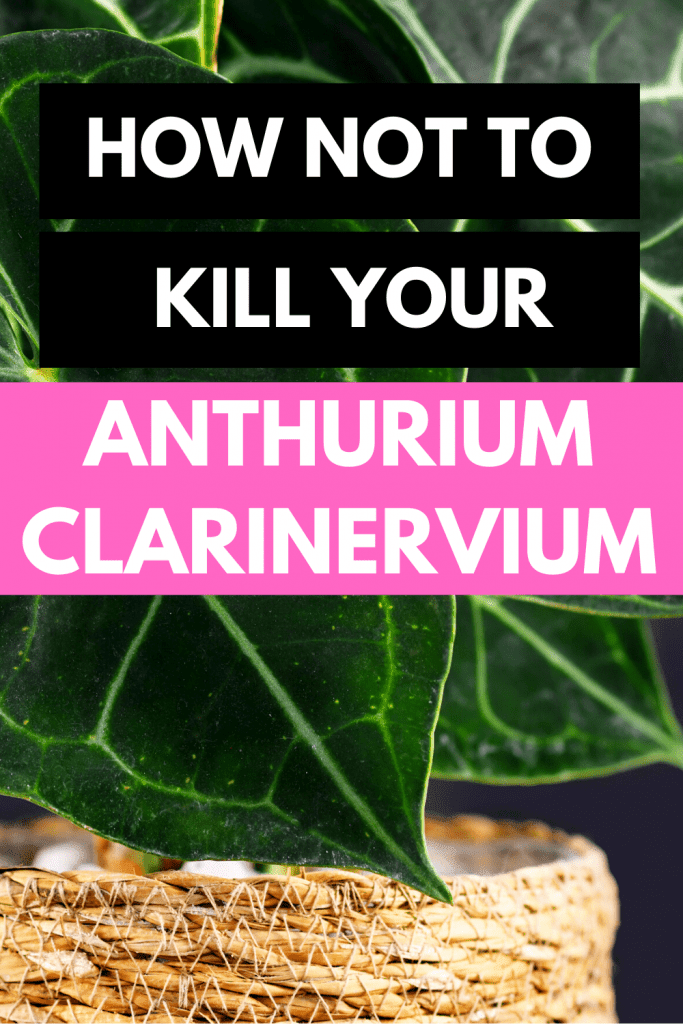
Anthurium clarinervium Takeaways
| Species | Anthurium clarinervium |
| Synonyms | Anthurium clarinervium Matuda, White Veined Anthurium, Queen Anthurium, Velvet Cardboard Plant |
| Family | Araceae |
| Genus | Anthurium |
| Growth | Large, thick leaves growing in a rosette pattern |
| Height | 4.5 feet |
| Width | 3.3 feet |
| Soil | Loose well-draining soil using orchid bark |
| Watering | Every 5 to 7 days |
| Light | Bright indirect feet |
| Temperature | 64 - 70°F |
| Humidity | 60 to 80% |
| Fertilizer | Fertilize month |
| Propagation | Root division, stem cuttings |
Table of Contents
Anthurium Clarinervium Plant Care
Soil
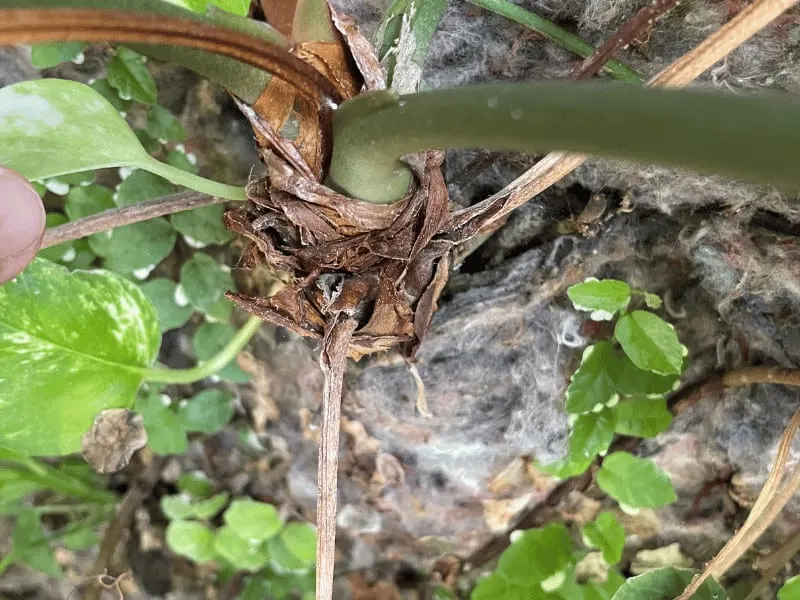
Loose and well-draining soil is a must-have, as these plants are epiphytes. They’re prone to root rot and other conditions caused by too much water and moisture.
Acidic soil with a 5.5 pH to 6.5 pH is best.
To create air pockets in the potting mix, I use a soil mix consisting of:
- Douglas fir bark
- Perlite
- sphagnum moss
All you have to do is mix the three ingredients. There should be more perlite and sphagnum moss than bark. The ideal ratio is 5 to 1.
The perlite retains water. Since you’re not using average potting soil, you need a material that retains some moisture.
Watch how the water drains through the soil and the plant pot. Make sure it’s draining as fast as it should be.
You can also grow it in 100% Sphagnum moss. You have to be careful not to let the moss dry out completely and avoid it from becoming too wet, from my experience.
Light
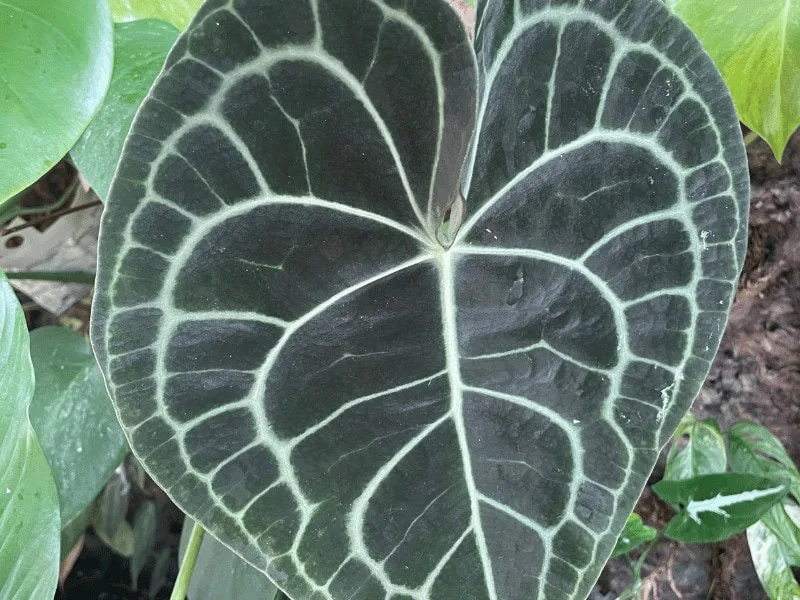
Provide bright indirect light. Keep your Anthurium clarinervium plant away from direct sunlight.
This means keeping it away from windows with direct sunlight coming through. Don’t sit it under any grow lights either.
Direct sunlight can burn and scorch your plant. It’s very sensitive to the sun and heat.
Filtered sunlight is the easiest option. Placing the plant on an east-facing window is a great way to gain filtered sunlight. A north-facing window works as well.
Anthurium clarinervium plants need at least indirect light. They thrive with medium light in brightness.
Watering

Water your plant about once a week. You don’t want to over-water the plants, but you don’t want to dehydrate them either.
Overwatering your plant can cause nasty root rot. Root rot rots the entirety of the roots until the plant dies. It’s important to make sure you’re using a self-draining pot.
During the growing season, you want the soil for the plant to be moist. Don’t water it until the first two soil layers are dry, about 2 inches down (5 cm).
You can test the moistness of your plant by pushing your finger through the soil. The soil should be dry up to your second knuckle.
Outside of the growing season in Spring and Summer, you don’t need to water your plant as much. The soil retains water easier during the colder months.
Be careful; it’s easy to over-water your plant during dormancy. You’ll only need to water your plant twice a month.
Temperature
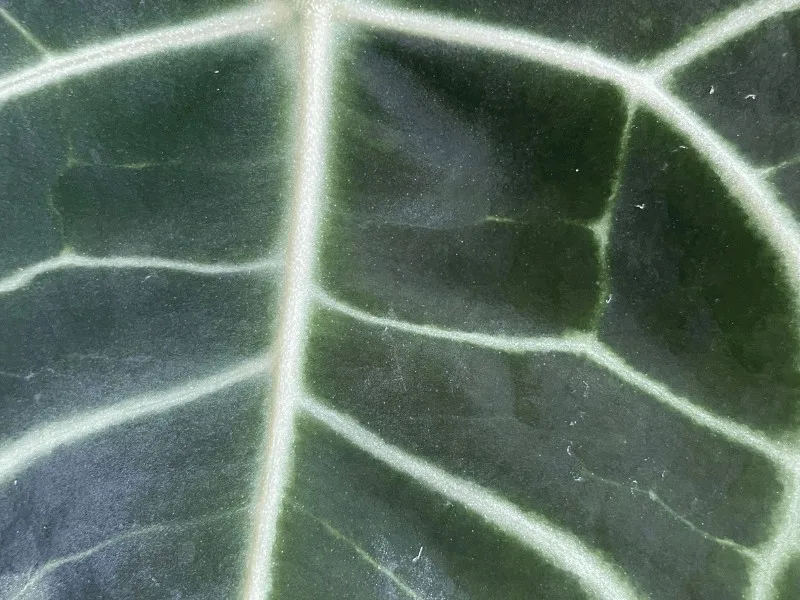
The right temperature depends on the time of year.
For the growing season, the temperature for the plant needs to be between 64F (18C) to 70F (21C).
For the rest of the year, the plant can take temperatures down to 54F (12C). But it shouldn’t drop more than this, or your plant will stop growing and freeze.
Humidity
These plants love high humidity. The humidity should be at least over 60%. But 80% or more is great.
High humidity speeds up the plant’s growth. The leaves (and veins) will turn a brighter green.
You can use a couple of methods to create high humidity for your plant.
The easiest way to create humidity is using a humidifier in the same room. There’s no work or serious upkeep.
You can also use pebbles and a tray. Fill the tray to the top with the pebbles. Then add water to the tray until it’s just under the pebbles. You don’t want the water to cover them.
Now, all you have to do is place your plant pot on top of the pebbles. As the water evaporates, it creates humidity. That humidity goes straight to your plant.
Fertilizer
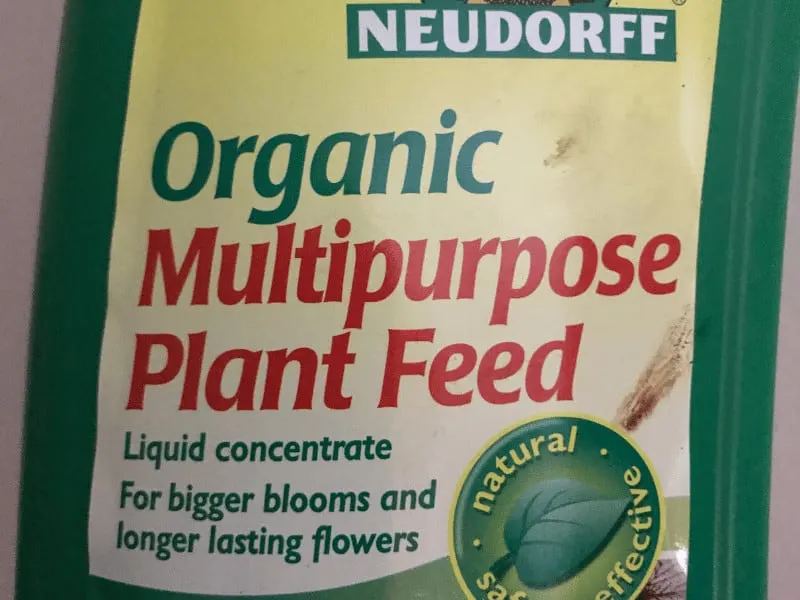
These plants don’t need as much fertilizing as most other plants do. Only use 1/2 of the recommended dosage. In my hydroponics setup, I had a few close calls where foliage and roots started to burn because of too much fertilizer.
When the growing season hits, fertilize the plant every two months. The rest of the year, you fertilize it once or twice altogether.
Always use half-strength indoor plant fertilizer. It should have a high amount of phosphorous in it. The phosphorous needs to be higher than all the other elements.
Mineral salt buildup can be an issue with an Anthurium clarinervium plant. To prevent mineral salt buildup, flush your plant’s soil every three or four months.
Flushing the soil is pretty simple. You run water through the soil for about two or three minutes.
The running water is running through any built-up mineral salt from fertilizer.
Growth
They can grow between 15 and 25 inches tall (28-64. cm) and 15 to 40 inches wide (28-101 cm). Again,
The leaves of these plants grow between 5 to 12 inches in length (13-30 cm).
Potting
You should re-pot an Anthurium clarinervium during springtime.
And you shouldn’t re-pot your plant unless it’s too big for the pot it’s in. Or you’re trying to promote its’ growth.
For this plant, that’s about every two or three years.
Re-potting an Anthurium clarinervium is pretty easy. It’s like re-potting any other houseplant.
Velvet Cardboard Anthurium Propagation Steps
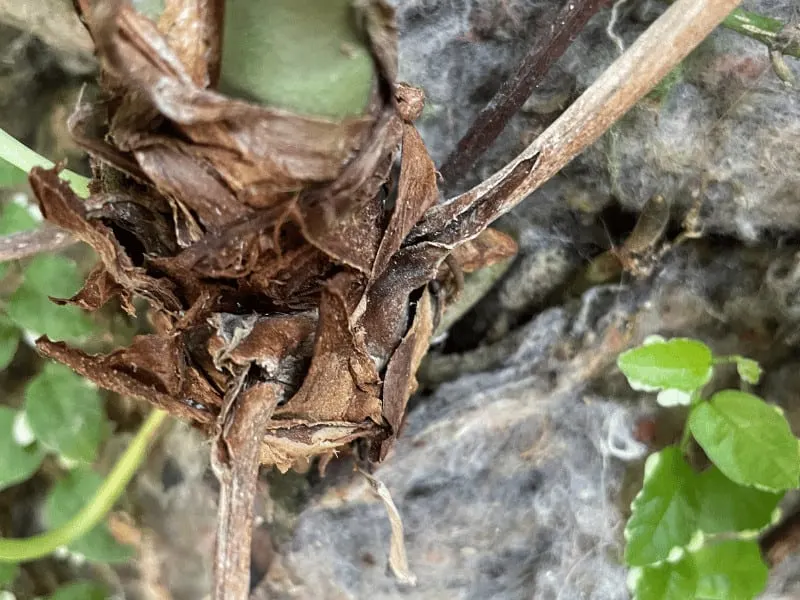
The Velvet Cardboard Anthurium can be propagated using root division at the stem. Carefully remove it from its pot, not damaging the roots. Gently rinse the soil from the roots using a faucet or hose. Separate a part of the plant. If the roots are attached, use a clean knife. Let the cutting callous over for 2-3 hours. Put the new part in its pot. Watering when the top soil layer is dry and provides indirect light.
Anthurium varieties
There are tons of Anthuriums to choose from outside the Anthurium clarinervium species.
The species listed below are some of my all-time favorites.
Anthurium magnificum x crystallinum
This Anthurium variety happens to be a favorite of mine. Unfortunately, I don’t have a picture as I don’t own one yet 🙂 It’s one gorgeous plant with pinkish or reddish leaves. It features the sized leaves of the magnificum combined with the sparkly shine of the chrystallinum.
Anthurium andreanum
Anthurium andreanum is another gorgeous plant with red, beige, to pink flowers or bracts. The leaves are heart-shaped and waxy.
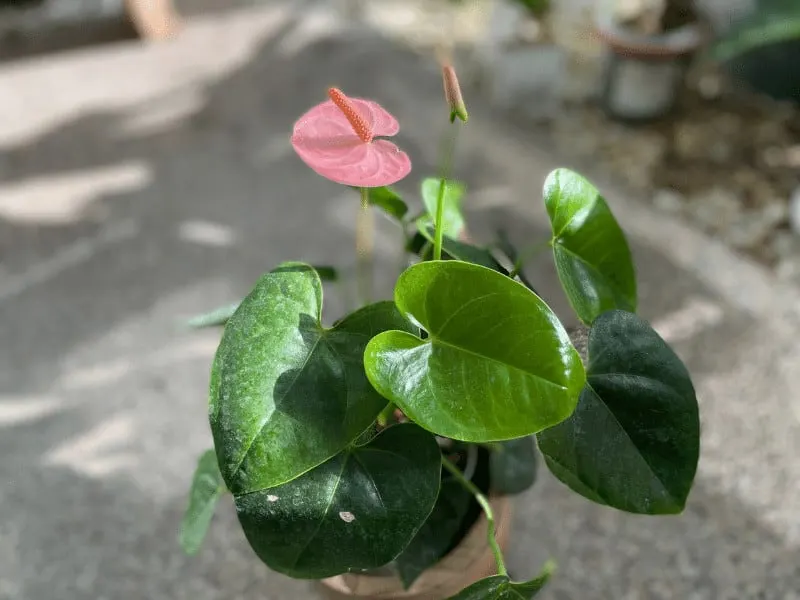
Anthurium scandens
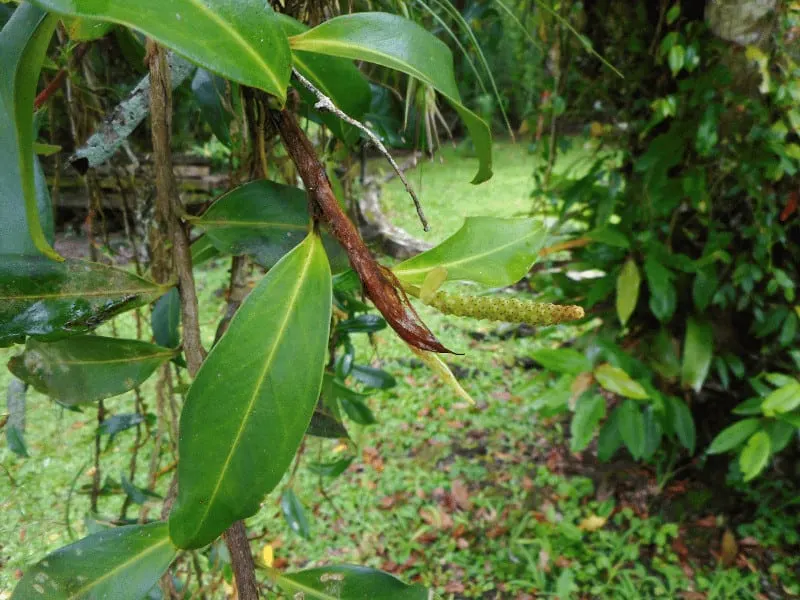
This plant is a climbing vine plant. Unlike other species on this list, the leaves on an Anthurium scandens plant don’t grow very large. They’re small leaves, only growing up to five inches in length.
Anthurium veitchii

The Anthurium veitchii is also known as the “King Anthurium.” These are large plants. So, you need a big room to grow one of these. The leaves alone can grow up to four feet in length.
Anthurium magnificum
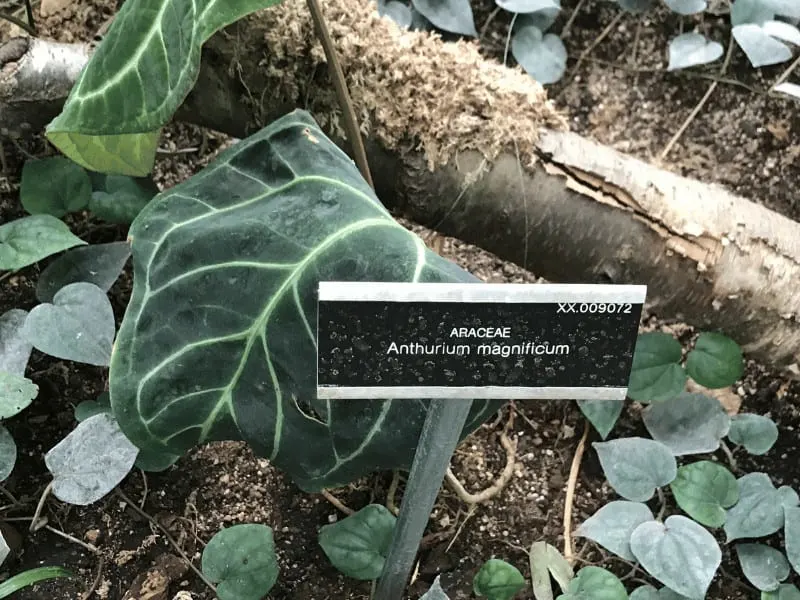
The Anthurium magnificum plant has large round leaves instead of elongated leaves. The white veins contrast against the dark green leaves.
Anthurium watermaliense
This plant is also known as the Black Anthurium plant for obvious reasons. The leaves look black, but they’re a deep purple in reality. The plant is perfect for anyone who loves dark things.
Anthurium warocqueanum

Since there’s a “King Anthurium,” there must be a “Queen Anthurium.” This species has super long velvety leaves. The Anthurium warocqueanum plant’s leaves can grow up to six feet tall (183 cm).
Anthurium pachyneurium
The “Big Red Bird” Anthurium plant has leaves that grow up instead of down. These leaves have a zig-zag pattern around the edges. It also has a very short stem. In bright light, the plant turns red.
Pests
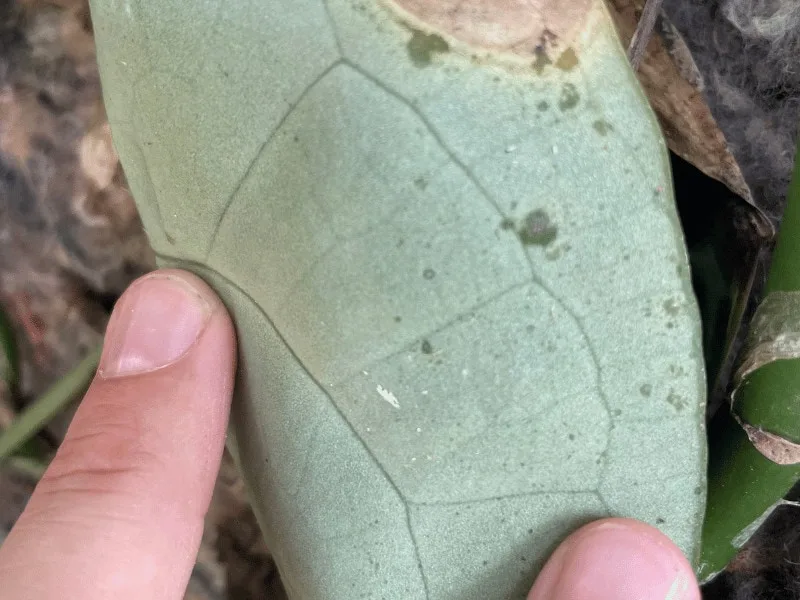
Since the Anthurium clarinervium needs such high humidity, it’s a hot spot for all pests.
It’s important always to check your plant for plant pests no matter what. If you bring new plants into your home, check them before you do so.
Mealybugs
One common pest problem comes from mealybugs. Mealybugs are strange and creepy-looking bugs. They look like they’re covered in a cottony substance.
This outer coating holds onto moisture so the bugs don’t overheat or dehydrate.
They also excrete a waxy substance as they feed. This is the waste from feeding. It sticks to the plant as they move about.
According to the University of Maryland, the waxy excretion leads to black sooty mold.
Mealybugs feed on the sap of your Anthurium clarinervium plant. This means they steal the nutrients and water your plant needs to thrive.
Mealybugs cause a wide list of problems for your plant. This can include yellow or droopy leaves or even stunted growth.
In extreme cases, mealybugs can even kill your plant. This only happens in a plant with a long-time infestation of the bug.
Spider Mites
Another common pest for Anthurium clarinervium plants is spider mites. Spider mites are arachnids but they’re often confused as insects.
These eight-legged pests are oval-shaped. Most of them are translucent, with two dark spots at their rear ends. The dark spots are where waste builds up from their feedings.
Like the mealybugs, spider mites steal the sap from your plant. This prevents your plant from going through photosynthesis so it can feed itself.
Since spider mites reproduce quickly, it doesn’t take long for an infestation to grow. The bigger the infestation, the worse the consequences for your plant.
Scale
The last common houseplant pest is the brown scale insect.
Brown scales lack armor or a protective covering to help them out. They’re oval-shaped and have long antennas. They’re also wingless.
Brown scales use their needle-sharp mouths to pierce through your Anthurium clarinervium plant. This strange mouth also allows them to suck up the sap. It’s as if their mouths are a straw.
With brown scales feeding on your plant, it will lose its vibrant colors and healthy glow. Instead, the plant starts to droop and wilt.
It’s very rare for a plant to die from a brown-scale infestation. The infestation has to get pretty bad to get to that point.
There are several natural ways to rid your Anthurium clarinervium plant of pests. Neem oil is always a great alternative to chemical pesticides.
Your Anthurium Clarinervium Plant’s Leaves are Turning Yellow
If your Anthurium clarinervium plant’s leaves turn yellow, it’s stressed out. In most cases, this means your plant has moisture or water stress. You’re either over-watering your plant, or you’re under-watering it.
Check the soil of the plant. The soil shouldn’t be saturated. If you’re over-watering, you need to water the plant less.
Overwatering causes less oxygen to get to the root system. The oxygen pockets in the soil get replaced by water. The first parts of the plant to show signs of this are generally the leaves, which will begin to turn yellow.
The soil shouldn’t be bone dry, either. Add some water and keep an eye on it.
Your Anthurium clarinervium Leaves Have Brown Tips or Edges
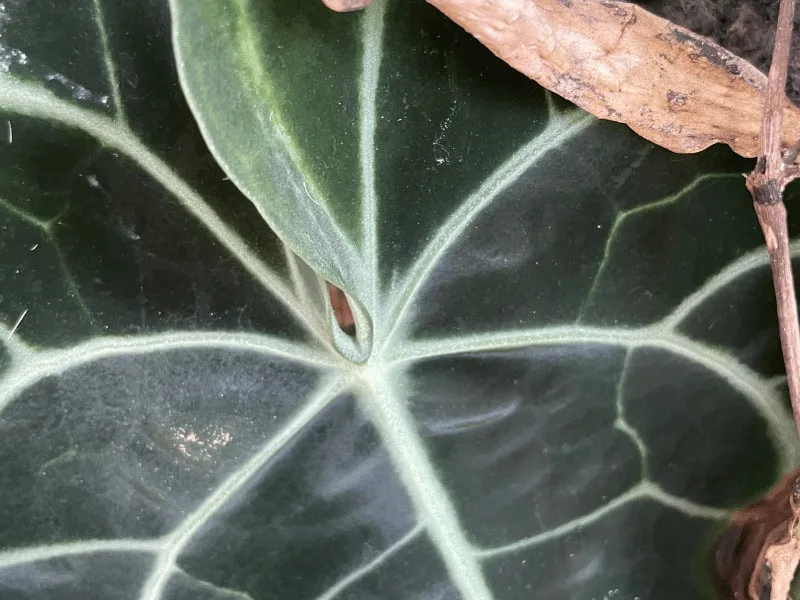
Anthurium clarinervium plants have brown tips if they aren’t receiving the humidity needed.
The thing to remember about tropical plants is that you need to mimic their natural habitats. Otherwise, they’re not going to thrive like you want them to.
One area to be accurate about is the high humidity of the Anthurium clarinervium plant.
As we stated earlier, an Anthurium clarinervium plant’s humidity must be at least 60%. But if you want optimal growth, the humidity should be around 80%.
Your Anthurium Clarinervium Plant’s Foliage is Dull
Anthurium clarinerviums with dull leaves and veins aren’t getting the light needed to be healthy.
Another major symptom of your plant lacking light includes slow or stunted growth.
When the plant isn’t getting the required light, it cannot go through photosynthesis. In other words, the Anthurium clarinervium plant can’t create all the nutrition it needs
When it’s low on light, your best choice is to put it in your window. But avoid your south or west-facing windows.
Stick to north or east-facing windows. It will get sunlight but not direct sunlight.
Anthurium Clarinervium Cultivars
There are several cultivars of the Anthurium around. You’ll find dozens for sale in garden centers and online. Even within the Anthurium Clarinervium you can see variety.
This is, however, generally caused by a hybrid activity rather than a different variety in itself. These hybrids often result in slightly different variations in leaf pattern, size, and appearance.
If you prefer the leaves to be richer, darker, and deeper green, go for the Anthurium clarinervium “Dark form.”
Also known as the Anthurium Clarinervium Tarantula, the deeper green on the leaves leads to more prominent-looking markings.
Is Anthurium clarinervium plants toxic?
Anthurium clarinervium plants are toxic if ingested. They’re toxic to both humans and pets. Ingesting an Anthurium clarinervium causes ulcers in your esophagus and your throat. They contain insoluble calcium oxalate chrystals, according to Pet Poison Helpline.
Conclusion
Anthurium clarinervium plants are gorgeous tropical plants and very easy to care for compared to other Anthuriums.

Daniel has been a plant enthusiast for over 20 years. He owns hundreds of houseplants and prepares for the chili growing seasons yearly with great anticipation. His favorite plants are plant species in the Araceae family, such as Monstera, Philodendron, and Anthurium. He also loves gardening and is growing hot peppers, tomatoes, and many more vegetables.


